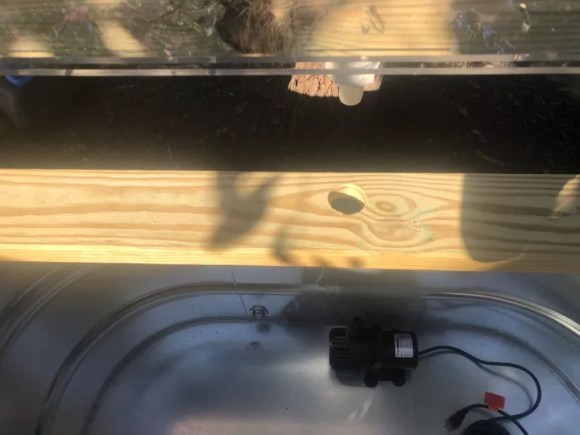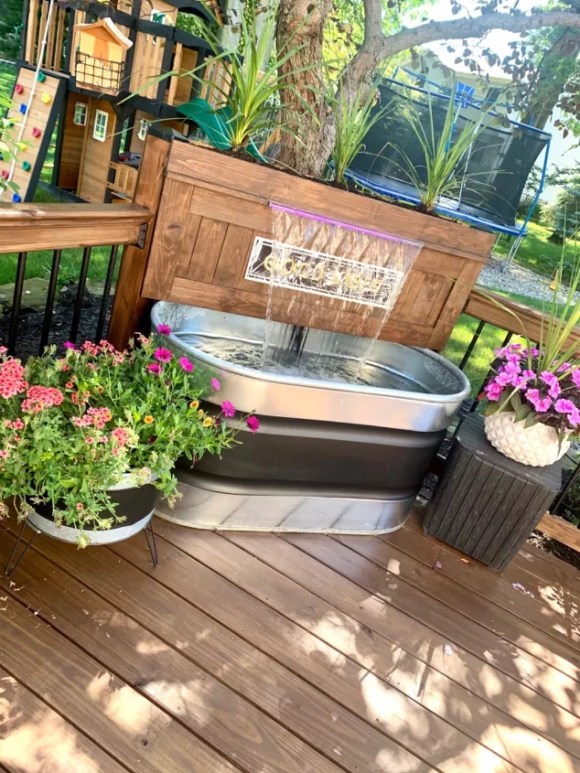Amidst the careful and intricate rejuvenation of our back deck.
A perfect opportunity presented itself to integrate a mesmerizing aquatic masterpiece.

Design Arrangement: Throughout the deck’s renovation, we respected the original structure. Choosing to refresh the upper deck boards, posts, and rails. Interestingly, a corner placement revealed itself as the perfect location for bringing my envisioned masterpiece to life.

Trial Installation: Using a four-foot water trough, I skillfully placed it between the two posts, ensuring its seamless blend while preserving precious deck area. This adjustment turned out to be a flawlessly fitting choice.

Crafting Supports: Creating braces from 2×6 planks, custom-fitted to match the distance between the two posts, I intricately placed the plank over the posts, precisely aligning and marking the angles. With the help of a jigsaw, I skillfully carved out each corner, allowing the brace to neatly interlock with the posts. I replicated this process to craft two identical reinforcements.

Creating Plumbing Openings: After securing the main brace in position, I checked the alignment of the spillway to ensure the inlet was perfectly centered. Using the tubing dimensions as a guide, I then proceeded to drill a hole with a diameter of one and a half inches.

Installing the Second Support: After securing the initial brace and completing the drilling, I contemplated the perfect height for the overflow. Placing it too high could lead to splashing and water wastage, while positioning it too low might affect the pleasing sights and sounds. After thoughtful contemplation, I decided on a placement roughly sixteen inches from the highest point of the trough. This marked the ideal spot for attaching the second brace, which I carefully notched to accommodate the spillway.

Placing the Spillway: Carefully fitting the spillway into the previously carved recess, I gave it a slight forward tilt to encourage smooth water movement. Adding the third brace on top, I applied gentle pressure to firmly secure the spillway in place. At the same time, I guided the tubing through the pre-drilled hole, establishing a concealed connection between the spillway and the pump positioned discreetly at the base of the trough.
Testing the Setup: After completing the assembly and making the necessary connections, I introduced a small amount of water into the trough to initiate an initial evaluation. This step aimed to verify the pump’s capacity to adequately supply the spillway. In my case, a 700-gallon-per-hour pump proved more than sufficient for the 24-inch spillway.

View from the Rear: Turning attention to the back view, the intricacies of the plumbing connections were revealed in a subtle yet intricate manner. Concealment will be accomplished through the application of galvanized metal, allowing for easy removal when drainage or repairs are needed while maintaining an unobtrusive appearance.

Finishing Touch: With operational success achieved, I skillfully utilized a collection of fence picket boards to conceal the plumbing infrastructure. This endeavor served a dual purpose, creating a charming raised planter. While not notably deep, it adds an aesthetically pleasing touch. To complete the project, I applied deck stain to ensure harmony with the existing deck and its newly installed railings. Electrical wiring was extended from an existing outlet, enhanced by an outdoor extension cord that’s controlled by a timer.
EMBRACE THE MAGIC!

